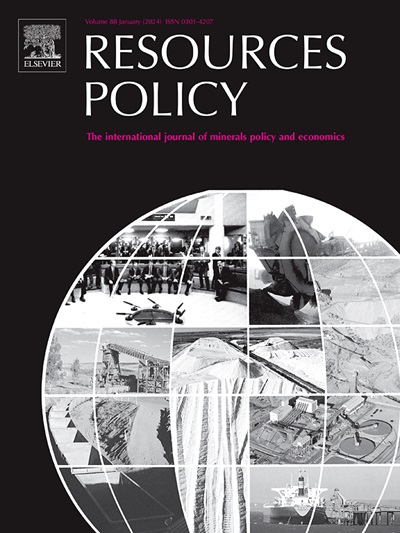Open-pit phase design considering operational constraints: Towards the generation of high adherence production planning policies
IF 10.2
2区 经济学
0 ENVIRONMENTAL STUDIES
引用次数: 0
Abstract
The conventional method for formulating open-pit mine production strategies suffers several drawbacks. One of them is that the generation of the extraction sequence is done in separate stages and does not consider the temporality of the extraction and processing decisions, so it does not maximize the net present value. In addition, the solutions obtained are difficult to implement because they do not ensure minimum operating spaces for the use of large mining equipment. Consequently, the process is performed sub-optimally. This work proposes a novel methodology to address the open-pit phase design under a mathematical programming approach. For this, an integer program generates phases that maximize an approximation of net present value and satisfy (i) minimum geometric spaces between phases and (ii) minimum and maximum capacities of the mining operation per phase, aiming for practical open-pit mine production planning policies. This methodology was applied in a case study, and the results show its ability to generate practical phases, obtaining differences in net present value lower than 2.02% compared to an optimization approach that does not consider these operational constraints. Therefore, the proposed open-pit mine extraction policy significantly improves its operational design without considerably affecting the expected value promise.
考虑操作约束的露天矿阶段设计:朝着制定高依从性生产计划政策的方向发展
制定露天矿生产战略的常规方法存在着一些缺陷。其中之一是提取序列的生成是分阶段进行的,没有考虑提取和处理决策的时效性,因此没有实现净现值最大化。此外,所获得的解决办法难以执行,因为它们不能确保为使用大型采矿设备提供最低限度的作业空间。因此,流程的执行不是最优的。这项工作提出了一种新的方法来解决在数学规划方法下露天矿阶段设计。为此,一个整数程序生成最大化净现值近近值的阶段,并满足(i)阶段之间的最小几何空间和(ii)每个阶段采矿作业的最小和最大容量,旨在制定实际的露天矿生产规划政策。该方法在一个案例研究中得到了应用,结果表明,与不考虑这些操作约束的优化方法相比,该方法能够产生实际阶段,获得的净现值差异低于2.02%。因此,所提出的露天矿开采策略在不显著影响预期价值承诺的前提下,显著改善了露天矿开采的操作设计。
本文章由计算机程序翻译,如有差异,请以英文原文为准。
求助全文
约1分钟内获得全文
求助全文
来源期刊

Resources Policy
ENVIRONMENTAL STUDIES-
CiteScore
13.40
自引率
23.50%
发文量
602
审稿时长
69 days
期刊介绍:
Resources Policy is an international journal focused on the economics and policy aspects of mineral and fossil fuel extraction, production, and utilization. It targets individuals in academia, government, and industry. The journal seeks original research submissions analyzing public policy, economics, social science, geography, and finance in the fields of mining, non-fuel minerals, energy minerals, fossil fuels, and metals. Mineral economics topics covered include mineral market analysis, price analysis, project evaluation, mining and sustainable development, mineral resource rents, resource curse, mineral wealth and corruption, mineral taxation and regulation, strategic minerals and their supply, and the impact of mineral development on local communities and indigenous populations. The journal specifically excludes papers with agriculture, forestry, or fisheries as their primary focus.
 求助内容:
求助内容: 应助结果提醒方式:
应助结果提醒方式:


